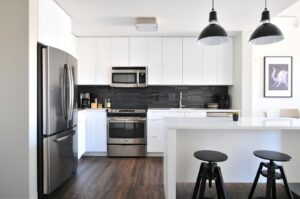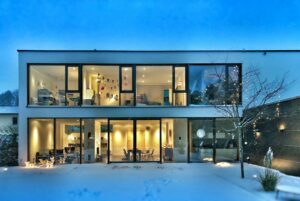TL;DR:
– Transitional Homes blend sustainability and technology for a futuristic lifestyle.
– They benefit the environment through energy efficiency and eco-friendly practices.
– Design elements include using sustainable materials and optimizing natural light.
– Smart technology enhances functionality and automation in Transitional Homes.
– Future trends focus on emerging design elements and technological advancements for sustainability.
Introduction
Are you ready to embark on a transformative journey towards a futuristic lifestyle? Explore the realm of Transitional Homes, where smart design meets sustainability for a harmonious living experience. As a seasoned advocate for innovative living spaces, I am thrilled to unveil 7 Proven Transitional Home Ideas that will redefine how you perceive modern living. Step into a world where function and beauty intertwine seamlessly, where every element is meticulously crafted to enhance your well-being and respect the environment. Join me on this adventure as we discover the possibilities of a sustainable future within the walls of your very own Transitional Home.
Why Choose a Transitional Home?
Imagine a home that seamlessly merges sustainability with modern living – that is the essence of a Transitional Home. By embracing innovative design and eco-conscious features, these homes offer a unique approach to sustainable living while reducing environmental impact.
What defines a Transitional Home?
A Transitional Home is a living space that combines elements of traditional and contemporary design with a focus on sustainability. These homes prioritize energy efficiency, use eco-friendly materials, and leverage smart technology to create a harmonious environment for residents.
How can a Transitional Home benefit the environment?
Transition Homes play a vital role in promoting eco-friendly practices by reducing energy consumption, minimizing waste, and incorporating green technology. By choosing a Transitional Home, residents contribute to a healthier planet while enjoying a modern and sustainable lifestyle.
What features make a Transitional Home unique?
Transitional Homes stand out for their use of sustainable materials, energy-efficient systems, and natural light optimization. These homes often incorporate smart technologies that enhance functionality and promote a greener way of living. With a focus on innovation and environmental responsibility, Transitional Homes pave the way for a more sustainable future.
Design Elements of a Transitional Home
Transitioning towards sustainable living involves thoughtful consideration of design elements in a Transitional Home. By incorporating eco-friendly materials, focusing on energy efficiency, and optimizing natural light, these homes can redefine modern living spaces.
1. Sustainable Materials
– Utilizing recycled or sustainable materials such as reclaimed wood, bamboo, or recycled glass can reduce environmental impact.
– Eco-friendly insulation options like cellulose or sheep’s wool provide better thermal regulation and reduce energy consumption.
– Low-toxicity paints and finishes contribute to healthier indoor air quality, promoting overall well-being.
2. Energy Efficiency
– Installing energy-efficient appliances, LED lighting, and smart thermostats can significantly reduce energy consumption.
– Proper insulation, double-glazed windows, and passive solar design principles help maintain comfortable indoor temperatures.
– By harnessing renewable energy sources like solar panels or wind turbines, Transitional Homes can achieve higher sustainability levels.
3. Optimization of Natural Light
– Incorporating large windows, skylights, and light tubes can maximize natural illumination, reducing the need for artificial lighting.
– Strategic placement of windows and shading devices can control heat gain and improve indoor comfort.
– Daylight harvesting systems can automatically adjust lighting levels based on natural light availability, enhancing energy savings.
These design elements not only enhance the aesthetic appeal of Transitional Homes but also contribute to a more sustainable and environmentally conscious lifestyle.
Sustainable Living in a Transitional Home
Living sustainably in a transitional home involves adopting eco-friendly practices that benefit both the environment and the occupants. By integrating green principles into daily living, these homes not only reduce their carbon footprint but also offer a healthier and more comfortable lifestyle for residents.
Eco-Friendly Practices
– Recycling and composting to reduce waste
– Using energy-efficient appliances and electronics
– Implementing water-saving fixtures and practices
– Growing a vegetable garden or using vertical farming techniques
Promoting a Healthy Lifestyle
Living in a transitional home promotes a healthy lifestyle through:
– Access to natural light and views of green spaces
– Indoor air quality improvements with proper ventilation
– Incorporating biophilic design elements for connection to nature
– Encouraging physical activity through walkable neighborhoods and outdoor amenities
Waste Reduction Strategies
– Implementing a zero-waste lifestyle with reusable items
– Composting organic waste for soil enrichment
– Reducing single-use plastics through sustainable alternatives
– Upcycling and repurposing materials for DIY projects
Embracing sustainable living in a transitional home not only fosters a greener environment but also enhances overall well-being for the occupants. By incorporating eco-friendly practices, promoting a healthy lifestyle, and focusing on waste reduction, residents can enjoy the benefits of living in a sustainable and thriving community.
Smart Technology in Transitional Homes
In the age of digitalization, smart technology hasn’t just invaded our workplaces and pockets, but our homes as well. Transitional homes are no exception, harnessing cutting-edge technology to enhance their functionality, ease of living, and even their environmental sustainability.
How can smart technology enhance the functionality of a Transitional Home?
Smart technology has the potential to significantly enhance the utility of a Transitional Home. With this technology, homes can be automated to enhance energy efficiency, from motion-sensing lights that only illuminate occupied rooms, to smart thermostats that learn your routine and adjust the temperature accordingly, reducing energy waste.
What are some examples of cutting-edge technology used in Transitional Homes?
Transitional Homes may incorporate a variety of advanced technology. For instance, smart home hubs allow for central control of everything from your heating and cooling systems, to your lighting and security systems, all from a single device. Alternatively, solar panels and other renewable energy sources can be integrated into the home design to reduce reliance on the power grid.
How can automation contribute to the sustainability of a Transitional Home?
Automation plays a crucial role in promoting a Transitional Home’s sustainability. Automated systems can drive energy efficiency, limiting the use of resources only when necessary. For example, automated watering systems can give plants just the right amount of water, reducing waste, while smart appliances can minimize energy usage. Thus, automation not only makes a Transitional Home more convenient but also more sustainable, contributing to a healthier planet.
Future Trends in Transitional Home Development
As we look ahead to the future of home design and sustainability, the concept of Transitional Homes continues to evolve with new trends and innovations. These emerging developments are shaping the way we think about living spaces and the environment.
Emerging Trends in Transitional Home Design
– **Biophilic Design**: Incorporating nature into the design of Transitional Homes is increasingly popular, promoting a connection to the outdoors and enhancing well-being.
– **Modular Construction**: The use of pre-fabricated modules allows for quicker construction times and reduces waste, making it a more sustainable option for Transitional Homes.
– **Flexible Spaces**: Adaptive design elements that allow for multipurpose spaces are becoming more prevalent, catering to changing needs and lifestyles.
Technology Advancements
– **Smart Home Integration**: The integration of smart technology is becoming more sophisticated in Transitional Homes, with features like energy-monitoring systems and automated controls for lighting and appliances.
– **Renewable Energy Sources**: Transitioning towards renewable energy sources like solar panels and geothermal heating systems is a growing trend, reducing carbon footprints and energy costs.
– **IoT Connectivity**: The Internet of Things is revolutionizing home automation, enabling seamless connectivity between devices and enhancing the sustainability of Transitional Homes.
The Future of Transitional Home Development
As technology continues to advance and sustainability becomes a top priority, we can expect to see even more innovative solutions in Transitional Home development. From futuristic designs to eco-friendly practices, the future of Transitional Homes looks promising in creating harmonious living spaces for both residents and the planet.
Continuing on this journey of innovation and sustainability, the next section will delve into the conclusion, summarizing the key takeaways from this exploration of Futuristic Homes and Sustainable Living.
Conclusion:
In this journey toward a futuristic lifestyle, embracing transitional home ideas offers a blend of functionality and style. From sustainable design to smart technology integration, our homes are evolving to meet the demands of tomorrow. By incorporating transitional home elements, we pave the way for a dynamic living environment that adapts to our changing needs. Let’s embark on this transformation together and explore the endless possibilities of a truly futuristic home. Start your transition today and unlock the potential of a modern living experience.










